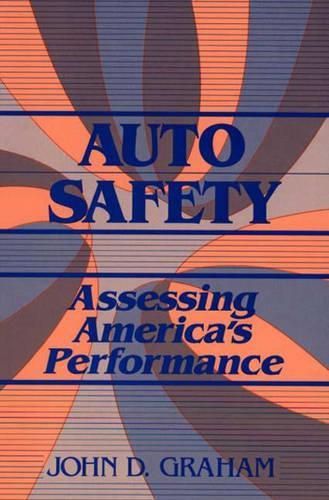
Auto Safety: Assessing America's Performance
(Hardback)
Publishing Details
Auto Safety: Assessing America's Performance
By (Author) John D. Graham
Bloomsbury Publishing PLC
Praeger Publishers Inc
30th March 1989
United States
Classifications
Tertiary Education
Non Fiction
Automotive technology and trades
629.220289
Physical Properties
Hardback
265
Description
America has struggled for 30 years to resolve controversy about the use of occupant restraint systems in motor vehicles. The book uses the differing perspectives of conflicting interests, democratic pluralism, to explain why it was so difficult to resolve the dispute and how the breakthrough toward resolution was ultimately achieved. Principles governing policymaking and corporate influences are explained and insights are provided for policymakers, corporate executives, lobbyists, consumer activists, attorneys and judges, and legislators who are participants in regulatory processes. America has struggled for thirty years to resolve controversy about the use of occupant restraint systems in motor vehicles. The book uses the differing perspectives of conflicting interests, democratic pluralism, to explain why it was so difficult to resolve the dispute and how the breakthrough toward resolution was ultimately achieved. Principles governing policymaking and corporate influences are explained and insights are provided for policymakers, corporate executives, lobbyists, consumer activists, attorneys and judges, and legislators who are participants in regulatory processes.
Reviews
"Auto Safety explains how air bags became the Maginot Line of regulatory politics. The contest was over who was going to build cars in America--Washington or Detroit. . .Public health people are too naive about the political process in Washington. Auto Safety lays it bare."-Chuck Hurley, Vice President, Public Policy National Safety Council
"Dr. Graham warrants high praise for having produced this unique history of a complex episode in auto safety. Well written, this book is at once masterful, comprehensive, and scholarly. It is a must for every student of American public policy."-General Robert F. McDermott, Chairman, USAA
"John Graham has dug further into the politics of automobile safety regulation than anyone else. His history is scrupulous, sophisticated, and optimistic about the capacity of our political institutions to deal responsibly with health and safety issues."-Christopher DeMuth, American Enterprise Institute
Graham's book is most interesting, and gives thorough coverage of the topic. The interviews he conducted bring to public understanding a wealth of information that otherwise would be lost. You will enjoy reading it.-Accident Analysis and Prevention
In his second book on automobile safety, author John Graham traces the history of how automobile safety failed in the U.S. marketplace, how seat belts and airbags became national political issues, and how Detroit and Washington fought over the power to determine how safe cars would be. By using personal interviews and extensive historical research, Graham recreates the unfolding course of democratic pluralism at work in automobile safety. Particular personalities had profound effects on this drama, and the author clearly shows these influences at work.-TR News
Only recently has automobile passenger safety become an extremely prominent concern of U.S. auto manufacturers and the general public alike. Traced here is the story of how auto safety first failed in the marketplace in the 1950s, how seat belts and air bags became a national political issue, and how leaders in Detroit and Washington battled over the power to determine how safe cars would be. Considering what has stood in the way of success over the years, America has achieved significant progress nevertheless in the 30-year struggle to increase occupant-crash protection through regulation. By 1988, the progress was seen in several of these tangible outcomes: installation of manual restraint systems in all seating positions of new cars; improvements in the comfort and convenience of manual systems; legislation in all 50 states requiring parents to restrain their infants and toddlers in cars; a transformation in public attitudes toward safety belts; significant reductions in the frequency and severity of injuries from crashes; and still more.-Sage Urban Studies Abstracts
"Graham's book is most interesting, and gives thorough coverage of the topic. The interviews he conducted bring to public understanding a wealth of information that otherwise would be lost. You will enjoy reading it."-Accident Analysis and Prevention
"In his second book on automobile safety, author John Graham traces the history of how automobile safety failed in the U.S. marketplace, how seat belts and airbags became national political issues, and how Detroit and Washington fought over the power to determine how safe cars would be. By using personal interviews and extensive historical research, Graham recreates the unfolding course of democratic pluralism at work in automobile safety. Particular personalities had profound effects on this drama, and the author clearly shows these influences at work."-TR News
"Only recently has automobile passenger safety become an extremely prominent concern of U.S. auto manufacturers and the general public alike. Traced here is the story of how auto safety first failed in the marketplace in the 1950s, how seat belts and air bags became a national political issue, and how leaders in Detroit and Washington battled over the power to determine how safe cars would be. Considering what has stood in the way of success over the years, America has achieved significant progress nevertheless in the 30-year struggle to increase occupant-crash protection through regulation. By 1988, the progress was seen in several of these tangible outcomes: installation of manual restraint systems in all seating positions of new cars; improvements in the comfort and convenience of manual systems; legislation in all 50 states requiring parents to restrain their infants and toddlers in cars; a transformation in public attitudes toward safety belts; significant reductions in the frequency and severity of injuries from crashes; and still more."-Sage Urban Studies Abstracts
Author Bio
JOHN D. GRAHAM is Associate Professor of Policy and Decision Sciences at the Harvard School of Public Health and Deputy Director of the New England Injury Prevention Research Center.
